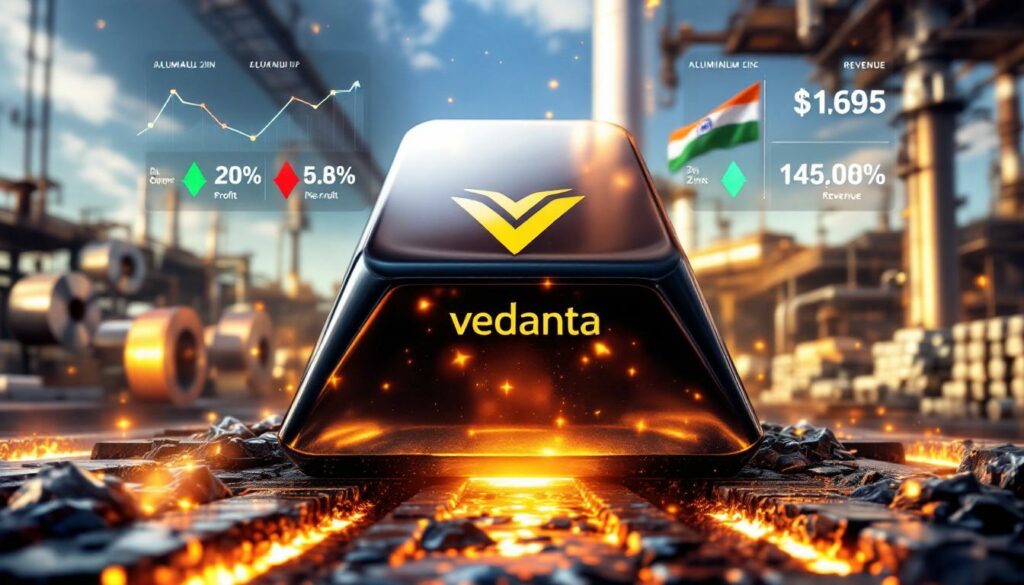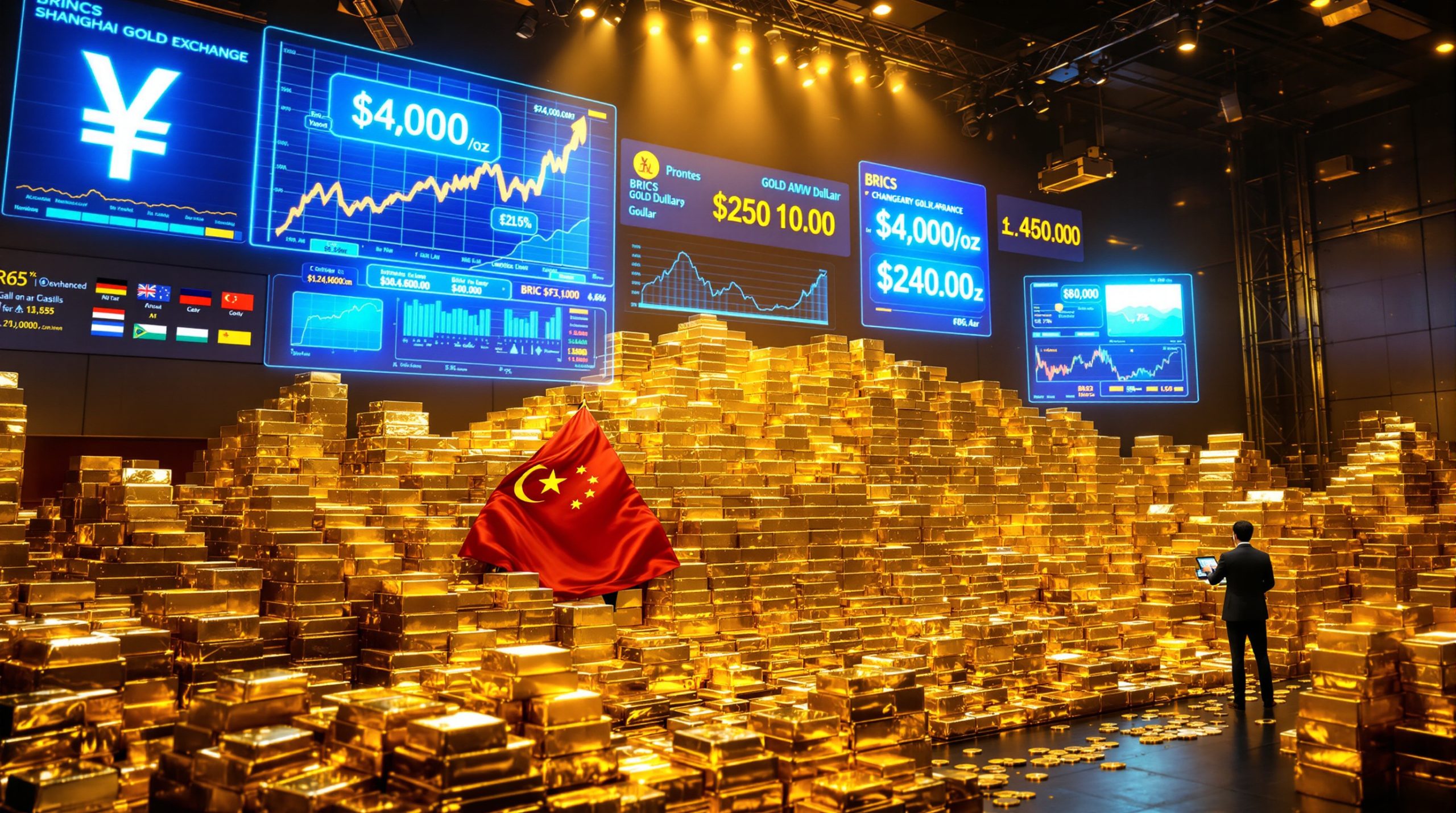Vedanta Misses Quarterly Profit Estimates on Weak Aluminium Prices
Vedanta, India's largest metals-to-oil conglomerate, reported lower-than-expected quarterly profits for the period ending June 30, 2025, primarily due to declining aluminium and copper prices in global markets. Despite these challenges, the company managed to increase overall revenue through higher sales volumes in key business segments.
The financial results highlight the vulnerability of major mining companies to commodity price fluctuations, with aluminium prices declining approximately 4% year-on-year during the reporting quarter. This price pressure has created significant headwinds for Vedanta's largest business segment.
Financial Performance Overview
Vedanta's quarterly profit fell to ₹31.85 billion ($4.3 billion), down from ₹36.06 billion in the same period last year, missing analyst expectations of ₹34.83 billion by approximately 8.5%. Despite profit pressures, the company achieved revenue growth of 6.2% year-on-year, reaching ₹374.34 billion.
EBITDA showed modest improvement at ₹60.53 billion, representing just a 2% increase compared to ₹59.26 billion in the previous year. Operating profit margins remained flat at 21%, demonstrating Vedanta's ability to maintain operational efficiency despite price headwinds.
A significant factor in the profit decline was the nearly doubled tax expenses, which surged to ₹15.96 billion from ₹8.31 billion in the same quarter last year. This substantial increase in tax policy challenges played a crucial role in the company missing analyst profit expectations.
"The substantial increase in tax burden, which nearly doubled year-on-year, created a significant drag on Vedanta's bottom line. Without this tax increase, profit figures would have been much closer to market expectations," noted industry analysts following the company's results announcement.
What Factors Drove Vedanta's Revenue Growth Despite Market Challenges?
Despite facing headwinds from lower commodity prices, Vedanta demonstrated resilience through increased production volumes and strategic business segment performance. The company's diversified portfolio helped offset some of the impacts of weak aluminium prices.
Business Segment Performance
The aluminium division, Vedanta's largest revenue contributor, achieved 7.7% revenue growth despite price pressures. This growth was primarily volume-driven, showcasing the company's ability to increase production and sales even in challenging market conditions.
Vedanta's copper division emerged as a standout performer with an impressive 34.6% revenue increase year-on-year. This robust growth underscores the company's operational capabilities in scaling copper production to capitalize on market opportunities, particularly in light of recent copper price prediction trends.
The zinc business, primarily through subsidiary Hindustan Zinc, posted better-than-expected profits. Unlike the aluminium segment, Hindustan Zinc benefited from strong domestic demand in India, which partially insulated it from global zinc price weaknesses.
Market Conditions Impacting Results
Benchmark three-month aluminium on the London Metal Exchange declined 4% year-on-year during the reporting quarter, creating significant pressure on Vedanta's largest business segment. Similarly, copper prices dropped 4.1% compared to the same quarter last year.
These price declines were attributed to several factors:
- Ongoing geopolitical tensions affecting global industrial activity
- Uncertainty surrounding US trade policies and their tariff impact on markets
- Supply-demand imbalances in key markets
- Slower-than-expected industrial growth in major economies
Why Is Aluminium So Critical to Vedanta's Business Model?
Aluminium represents Vedanta's largest business segment and plays a pivotal role in the company's overall financial performance and strategic positioning in the global metals market.
Aluminium's Strategic Importance
Aluminium accounts for nearly 40% of Vedanta's total revenue, making it the single most important contributor to the company's financial results. As India's largest aluminium producer, Vedanta has established a dominant market position with significant economies of scale.
The company's integrated aluminium operations span from bauxite mining to alumina refining and aluminium smelting, creating value across the entire production chain. This vertical integration provides cost advantages but also increases exposure to global aluminium price fluctuations.
Vedanta's aluminium business features:
- Multiple smelting facilities across strategic locations in India
- Self-sufficient power generation capabilities to support energy-intensive smelting
- Advanced technologies to improve operational efficiency
- Growing focus on value-added aluminium products for premium markets
Business Segment Hierarchy
Vedanta's revenue distribution highlights the critical importance of aluminium to the overall business:
- Aluminium: Primary revenue driver (40% of total revenue)
- Zinc: Second-largest business segment through Hindustan Zinc
- Copper: Third-largest segment with strong recent growth
- Oil & Gas: Through Cairn India operations
- Iron Ore: Smaller but strategic segment
This diversification provides some protection against commodity-specific downturns, but the outsized contribution from aluminium means the company remains particularly sensitive to fluctuations in global aluminium markets.
How Are Commodity Price Fluctuations Affecting Mining Companies?
The recent quarter highlighted the vulnerability of mining and metals companies to global commodity price movements, creating both challenges and opportunities across the sector.
Impact of Price Volatility
Lower selling prices for aluminium and copper have squeezed profit margins across the mining industry. Companies are increasingly focused on volume increases to offset price declines, as evidenced by Vedanta's strategy of boosting production across business segments.
"Commodity price volatility has become the new normal for mining companies. The successful players will be those who can continuously optimize operations to weather price downturns while positioning for upside during recovery periods," explains a mining industry analyst.
Cost reduction and operational efficiency have become paramount, with companies investing in automation, process improvements, and energy efficiency to protect margins during price downturns.
Market differentiation has become evident, with companies possessing diversified portfolios demonstrating greater resilience. Vedanta's multi-metal approach provides some insulation against single-commodity price shocks, though aluminium's large contribution still creates significant exposure.
Global Market Dynamics
Several factors are influencing current commodity market conditions:
- Industrial activity: Manufacturing output in major economies has shown inconsistent performance
- Construction sector: Infrastructure development in emerging markets continues to drive demand
- Economic growth patterns: Uneven regional recovery rates affecting metal consumption
- Green technology transition: Growing demand for metals used in renewable energy and electric vehicles
- Inventory levels: Strategic stockpiling and releases influencing short-term price movements
Regional variations in market recovery have created a complex landscape for global miners. While some markets show robust demand growth, others face persistent challenges, creating an uneven playing field for companies with different geographic exposures.
What Steps Is Vedanta Taking to Address These Challenges?
While Vedanta's financial results release didn't detail specific strategic initiatives, industry analysis suggests several approaches mining companies typically employ during periods of price pressure.
Potential Strategic Responses
Cost optimization remains a critical focus area for Vedanta and its peers. The company's ability to maintain operating profit margins at 21% despite price pressures suggests effective cost management is already in place. Key areas likely include:
- Energy efficiency improvements in aluminium smelting
- Logistics and supply chain optimization
- Digital transformation to enhance operational visibility
- Workforce productivity initiatives
Production volume increases have been a clear strategy, as evidenced by the revenue growth across business segments despite price declines. By producing and selling more units, even at lower prices, Vedanta has managed to grow overall revenue.
Diversification across multiple commodity segments provides natural hedging against individual metal price fluctuations. Vedanta's portfolio spanning aluminium, zinc, copper, oil & gas, and iron ore creates resilience against single-commodity downturns.
Value-added products with higher margins represent a potential growth avenue. Developing specialized aluminium products for automotive, aerospace, or packaging industries could command premium pricing less susceptible to commodity price swings.
Sustainability initiatives are increasingly important in the metals sector. Developing low-carbon aluminium products could position Vedanta to capture premium pricing from customers with environmental commitments. The company has been investing in green aluminium production technologies that may yield competitive advantages in the coming years.
How Does Hindustan Zinc's Performance Compare to the Parent Company?
As a significant subsidiary of Vedanta, Hindustan Zinc's performance provides additional context for understanding the broader company's results and demonstrates how regional market dynamics can influence segment outcomes.
Hindustan Zinc Performance
Hindustan Zinc posted better-than-expected profits during the quarter, bucking the trend of the parent company's results. This outperformance can be attributed to strong domestic demand in India, which provided a buffer against the global zinc price weaknesses affecting international markets.
The subsidiary benefits from several strategic advantages:
- Market leadership: Dominant position in Indian zinc market
- Cost position: Among the lowest-cost zinc producers globally
- Mine quality: High-grade zinc deposits enhancing production economics
- Integrated operations: From mining to smelting and refining
These factors have allowed Hindustan Zinc to maintain stronger profitability even as global zinc prices face pressures similar to those seen in aluminium markets. The subsidiary's performance highlights the value of Vedanta's diversified portfolio approach.
What Are the Implications for Investors and Market Outlook?
The latest quarterly results provide several key insights for investors considering Vedanta's position and future prospects in the global metals market.
Investment Considerations
Tax impact was a major factor in the profit miss, with expenses nearly doubling year-on-year to ₹15.96 billion. Investors should monitor whether this represents a one-time increase or a new normal for Vedanta's tax burden. The company's effective tax rate will be a key metric to watch in coming quarters.
Volume growth across business segments demonstrates operational capacity and market demand for Vedanta's products. The company's ability to sell increased production volumes even in challenging price environments suggests strong commercial capabilities and customer relationships.
Margin stability at 21% operating profit margin, despite significant price headwinds, indicates effective cost management. This resilience provides some downside protection should commodity prices remain under pressure.
Segment diversity benefits were evident in the results, with different performance across business units demonstrating portfolio advantages. The strong performance in copper (34.6% revenue growth) helped offset challenges in other segments.
Forward-Looking Indicators
Commodity price trends will continue to significantly impact Vedanta's performance. Investors should closely monitor aluminium and copper price movements on global exchanges, as these will be leading indicators for future results.
Domestic demand strength in India provides some insulation from global market weaknesses. The country's infrastructure development plans and manufacturing growth create a supportive environment for metal consumption, particularly benefiting Hindustan Zinc.
Cost management capabilities will remain crucial for margin protection. Vedanta's ongoing investments in operational efficiency and productivity improvements will be important to watch as the company navigates price pressures.
Tax rate stabilization could improve profit performance in future quarters if the elevated tax expenses normalize. Any regulatory changes affecting mining taxation in India or other operating jurisdictions could significantly impact bottom-line results.
"For investors in mining companies like Vedanta, understanding the relationship between production volumes, commodity prices, and cost structures is essential. While price movements grab headlines, operational execution often determines which companies outperform during challenging market conditions," notes a metals and mining industry trends analyst.
FAQs About Vedanta's Financial Performance
What caused Vedanta to miss profit estimates this quarter?
Vedanta missed profit estimates primarily due to lower global aluminium and copper prices, with benchmark aluminium declining 4% year-on-year. Additionally, tax expenses nearly doubled to ₹15.96 billion, creating significant pressure on the bottom line despite revenue growth of 6.2%.
How important is the aluminium business to Vedanta?
Aluminium is Vedanta's most significant business segment, contributing approximately 40% of the company's total revenue. As India's largest aluminium producer, this division's performance has an outsized impact on overall company results, making it particularly sensitive to global aluminium price movements.
Did any of Vedanta's business segments perform well despite market challenges?
Yes, Vedanta's copper division showed particularly strong performance with 34.6% revenue growth year-on-year. Additionally, the company's zinc subsidiary, Hindustan Zinc, posted better-than-expected profits despite global price pressures, benefiting from strong domestic demand in India.
How did tax expenses affect Vedanta's quarterly results?
Tax expenses nearly doubled from ₹8.31 billion to ₹15.96 billion year-on-year, representing a significant drag on net profit. This substantial increase in tax liability was a key factor in the company missing analyst profit expectations of ₹34.83 billion.
What market factors are currently affecting aluminium prices?
Global aluminium prices declined approximately 4% year-on-year during the reporting quarter, primarily due to geopolitical tensions and uncertainty surrounding US trade policies. Additionally, uneven industrial recovery across major economies and fluctuating inventory levels have contributed to price volatility.
Further Exploration
Investors interested in understanding commodity market dynamics should monitor several indicators beyond Vedanta's specific performance:
- LME warehouse levels: Aluminium inventory changes often precede price movements
- Chinese production data: As the world's largest aluminium producer, Chinese output significantly influences global markets
- Energy costs: Aluminium smelting is energy-intensive, making power prices a key cost driver
- Green premium development: Price differentials for low-carbon aluminium versus standard production
- Regional premiums: Physical delivery premiums above LME prices in different markets
These factors will likely influence Vedanta's performance in coming quarters as the company navigates the challenging global commodity price environment while leveraging its diversified portfolio and operational capabilities.
Furthermore, the company's bauxite project benefits could provide a competitive advantage in securing raw material for aluminium production, potentially helping to offset some of the margin pressures from weak aluminium prices.
Disclaimer: This analysis contains forward-looking statements about commodity markets and company performance. Actual results may vary significantly based on market conditions, regulatory changes, and other factors beyond Vedanta's control. Investors should conduct their own research before making investment decisions.
Looking for an Edge in Commodity Investing?
Discover real-time alerts on significant ASX mineral discoveries with Discovery Alert's proprietary Discovery IQ model, helping you identify actionable opportunities before the broader market. Explore why major mineral discoveries can lead to exceptional returns by visiting the dedicated discoveries page and position yourself for market-leading advantage.




